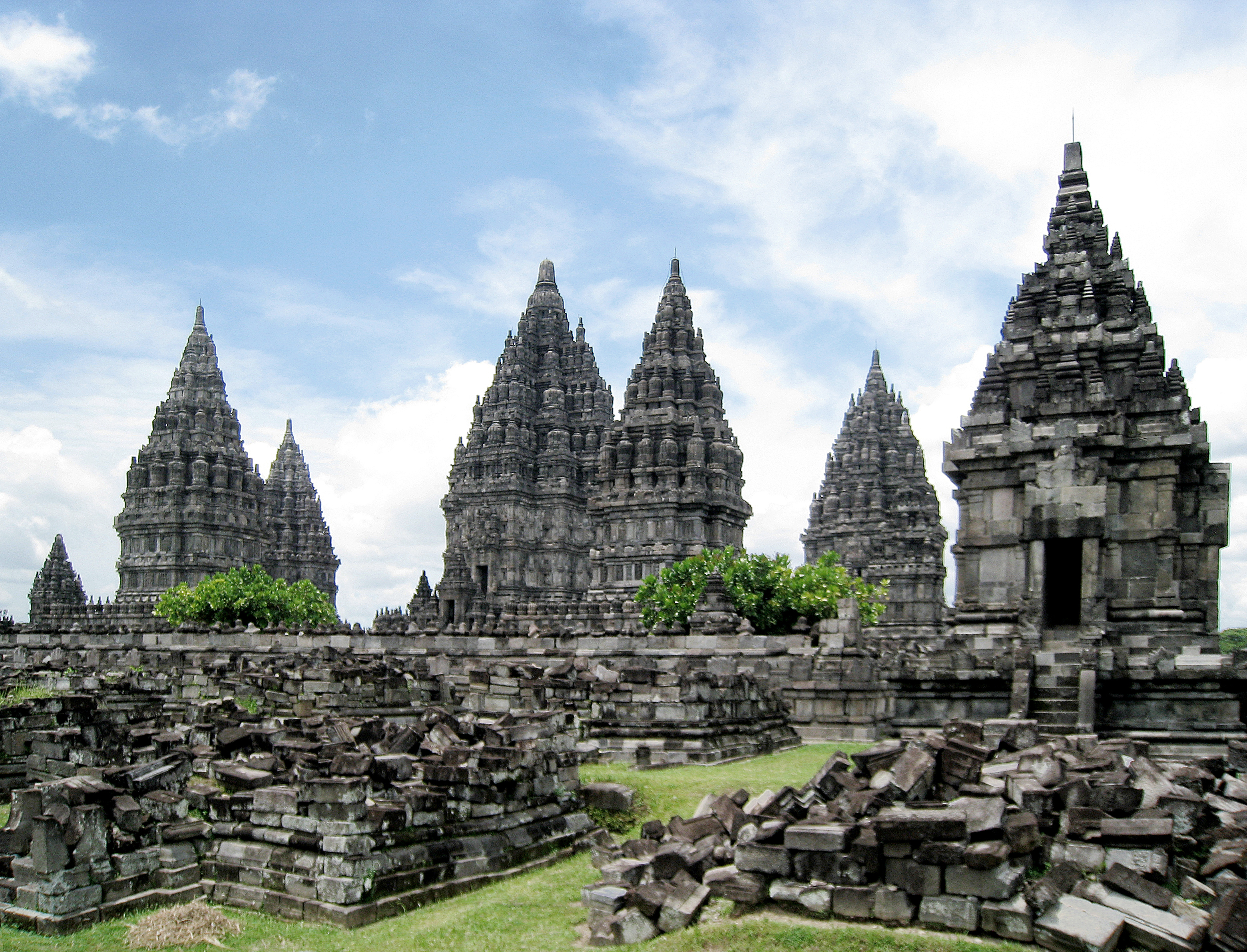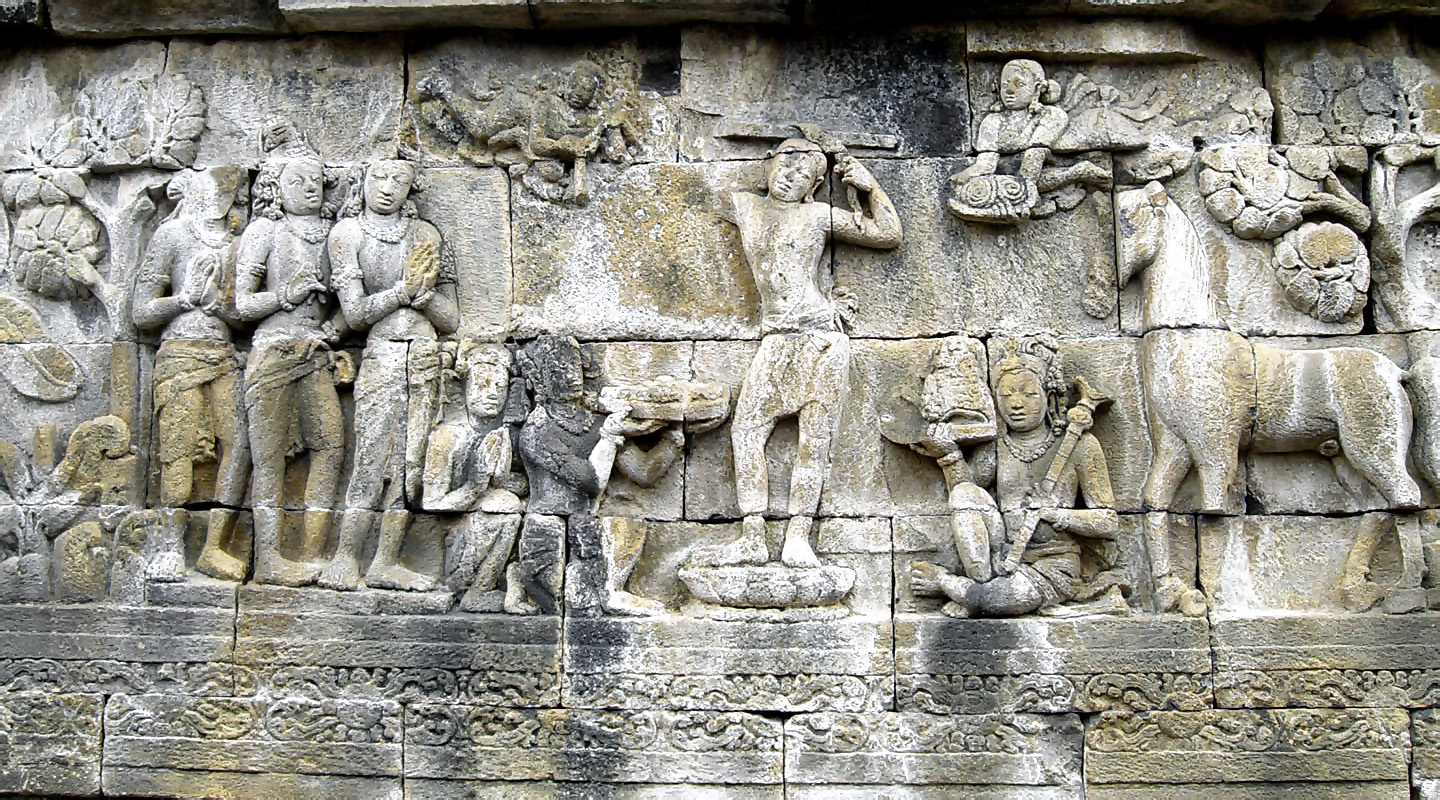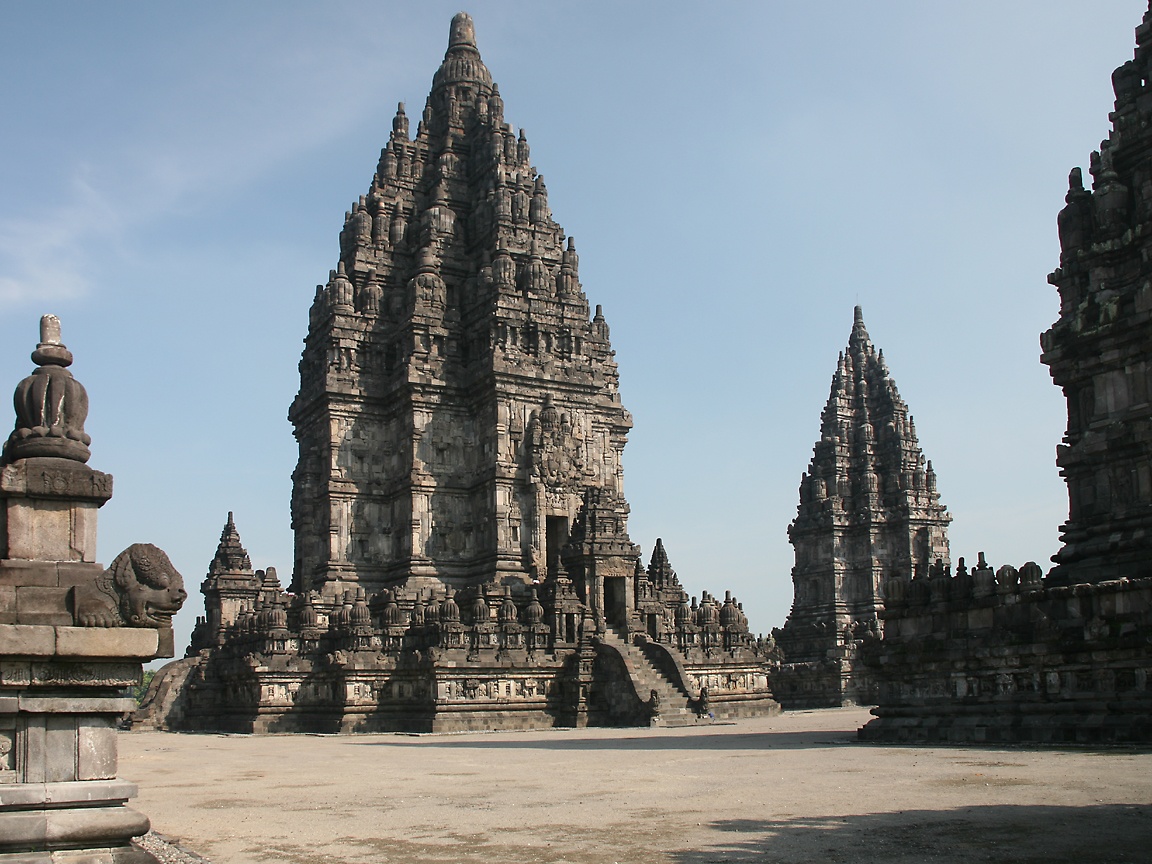Borobudur and Prambanan

I woke up at 7:30 - typically an early start for me, but not for a trip to Borobudur and Prambanan. Organized tours visiting both sites often leave before dawn! I considered booking a group tour since they were so cheap. A trip to Borobudur cost less than 10 dollars, and the combined excursion was only a few dollars more.
But the tour companies were only providing transport to and from. They simply drop off the group at the temple; you pay the entrance fee and take a self-guided tour. I was disappointed that the tour didn't include a guide, and considering tourists can get to the temples by public transport, I decided to go on my own.
 |
| A city bus station; I noticed a handful of tourists were also going to Borobudur on their own |
The trip wasn't overly taxing, but it did take up more time. All told the city bus, waiting at the station, and the regional bus (with stops) to Borobudur took 1.5 hours. Add in breakfast and figuring out the correct buses to take and by the time I got to Borobudur it was already after 10 am.
To avoid the crowds, my guidebook advised travelers to arrive as early as possible. While I was visiting during late morning and early afternoon, however, the temple was surprisingly quiet. The local guide I hired for a short tour said the previous weeks during Ramadan and Idul Fitri - the holiday celebrating its conclusion - Borobudur was swamped with domestic tourists. Luckily I just missed out on the busiest time of the year.
There certainly were other tourists around, but the sheer size of Borobudur spread us out over the complex. The temple, a truly massive structure, contains nine separate levels, 504 Buddha statues, and 2,672 relief panels. The panels depict scenes from daily life in Java as well as mythical creatures which carry symbolic meaning. The carvings are aesthetically similar to Indian sculptures. If you have seen pictures of Borobudur its probably been of the top levels, with one central stupa surrounded by 72 smaller ones. Watching sunrise or sunset from the top of the temple would have been amazing, but the views during the day aren't bad either.
Amazingly no mortar binds the temple blocks together. One could conceivably dismantle the walls, block by block (assuming he or she could lift them!). The blocks are positioned so they fit together like puzzle pieces. Borobudur was likely constructed in the 9th century, and despite numerous earthquakes has stood the test of time. A big reason is precisely because the blocks have some leeway; they can move during a tremor while the foundation remains solid. The complex didn't escape those earthquakes scratch free - it underwent extensive restoration multiple times last century. Check out this wiki page for more info on the temple.
After the short guided tour, exploring on my own, and a trip to the museum, I walked to a second, much smaller temple some 2 miles from Borobudur. Once I caught a bus back to town (with one transfer) the afternoon was almost over. Prambanan, another well-known temple, was on the east side of Yogya (Borobudur is west of the city). I could reach Prambanan from the town center without any transfers, but by the time I got there it was just after 5 pm - closing time.
I still planned to leave Yogya the following day, but when I checked at the train station there were no tickets available. So I booked a seat for the day after and figured it would work out to see Prambanan after all.
The following morning I rented a motorbike and drove to Prambanan. Getting there by public transport was easy, but my guidebook had suggested visiting several smaller temples close to Prambanan, but not close enough to walk. In the afternoon I could also take the bike out for a drive in the countryside.
Whereas Borobudur is a Buddhist temple, Prambanan is Hindu. At one point there were hundreds of temples constituting what we collectively refer to as Prambanan. They were also built in the 9th century, about 50 years after Borobudur, but time has not been as kind to the Hindu monuments. Many of the temples are simply mounds of blocks. Fortunately the main site has several structures in better shape, and renovation work is underway.
To avoid the crowds, my guidebook advised travelers to arrive as early as possible. While I was visiting during late morning and early afternoon, however, the temple was surprisingly quiet. The local guide I hired for a short tour said the previous weeks during Ramadan and Idul Fitri - the holiday celebrating its conclusion - Borobudur was swamped with domestic tourists. Luckily I just missed out on the busiest time of the year.
 |
| The temple at sunrise (well maybe it's not this photogenic every day!) |
There certainly were other tourists around, but the sheer size of Borobudur spread us out over the complex. The temple, a truly massive structure, contains nine separate levels, 504 Buddha statues, and 2,672 relief panels. The panels depict scenes from daily life in Java as well as mythical creatures which carry symbolic meaning. The carvings are aesthetically similar to Indian sculptures. If you have seen pictures of Borobudur its probably been of the top levels, with one central stupa surrounded by 72 smaller ones. Watching sunrise or sunset from the top of the temple would have been amazing, but the views during the day aren't bad either.
 |
| The temple is massive - those are people on the ground! |
 |
| One of the top levels of the temple |
 |
| One of the many reliefs that cover Borobudur's walls |
Amazingly no mortar binds the temple blocks together. One could conceivably dismantle the walls, block by block (assuming he or she could lift them!). The blocks are positioned so they fit together like puzzle pieces. Borobudur was likely constructed in the 9th century, and despite numerous earthquakes has stood the test of time. A big reason is precisely because the blocks have some leeway; they can move during a tremor while the foundation remains solid. The complex didn't escape those earthquakes scratch free - it underwent extensive restoration multiple times last century. Check out this wiki page for more info on the temple.
After the short guided tour, exploring on my own, and a trip to the museum, I walked to a second, much smaller temple some 2 miles from Borobudur. Once I caught a bus back to town (with one transfer) the afternoon was almost over. Prambanan, another well-known temple, was on the east side of Yogya (Borobudur is west of the city). I could reach Prambanan from the town center without any transfers, but by the time I got there it was just after 5 pm - closing time.
I still planned to leave Yogya the following day, but when I checked at the train station there were no tickets available. So I booked a seat for the day after and figured it would work out to see Prambanan after all.
The following morning I rented a motorbike and drove to Prambanan. Getting there by public transport was easy, but my guidebook had suggested visiting several smaller temples close to Prambanan, but not close enough to walk. In the afternoon I could also take the bike out for a drive in the countryside.
Whereas Borobudur is a Buddhist temple, Prambanan is Hindu. At one point there were hundreds of temples constituting what we collectively refer to as Prambanan. They were also built in the 9th century, about 50 years after Borobudur, but time has not been as kind to the Hindu monuments. Many of the temples are simply mounds of blocks. Fortunately the main site has several structures in better shape, and renovation work is underway.
 |
| In the foreground are the foundations of several temples, and behind them is the main and better preserved central complex |
 |
| The central tower stands an impressive 47 meters (154 feet) and is extravagantly carved |
 |
| The Sewu temple, half a mile from the main cluster (previous photo). It's in worse shape, but I only saw a handful of other tourists there as I was walking around |
Lonely Planet recommended visiting more temples surrounding Prambanan, so I took off to explore the area by motorbike. I found one of the smaller sites, which was empty save for the guard at the entrance booth. I showed him my ticket, but he indicated that the ticket was only for the main complex. The sign said visitors were free to make a donation; I already had coughed up nearly 20 dollars to see Prambanan (and 20 more for Borobudur), and I didn't feel like paying more for a small temple I would check out for 5 minutes. I tried to walk in and he stopped me; again he said "donation." It wouldn't have been any use trying to explain that if visitors were required to pay then entry was not by donation as the sign suggested. So I skipped out on the temple and went back to my moto.
That afternoon I went for a drive first in the countryside around Prambanan, then to Mount Merapi, north of the city. Merapi is Indonesia's most active volcano and erupted as recently as 2010. 360,000 villagers were evacuated and over 300 died; not all moved back and I found abandoned houses on the slopes. Despite its active status many locals have actually returned.
 |
| The 2006 Merapi eruption |
 |
| A house destroyed in 2010 |
 |
| In a scene reminiscent of Pompeii ash covers a home near Merapi |
I didn't try and hike; smoke bellows out of the cone 300+ days of the year and the area is often off-limits to tourists. I'll stick to riding a motorbike! And besides, by the time I arrived at the park entrance (the furthest I could ride), it was already late afternoon, time for me to head back toward Yogya. I ate another nasi ayam (rice and chicken) - I could eat probably eat that every day - before making my way back, via small village roads, to the city.
That night was another quiet one; there isn't much of a party scene in traditional Yogya and besides, I had to wake up before 7 am to catch my train!


Comments